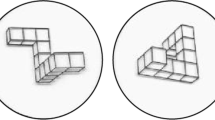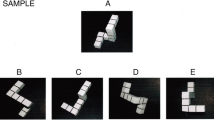Abstract
Mental rotation and line angle judgment performance were assessed in more than 90,000 women and 111,000 men from 53 nations. In all nations, men’s mean performance exceeded women’s on these two visuospatial tasks. Gender equality (as assessed by United Nations indices) and economic development (as assessed by per capita income and life expectancy) were significantly associated, across nations, with larger sex differences, contrary to the predictions of social role theory. For both men and women, across nations, gender equality and economic development were significantly associated with better performance on the two visuospatial tasks. However, these associations were stronger for the mental rotation task than for the line angle judgment task, and they were stronger for men than for women. Results were discussed in terms of evolutionary, social role, and stereotype threat theories of sex differences.


Similar content being viewed by others
References
Benton, A., Varney, N., & Hamsher, K. (1978). Visuospatial judgment: A clinical test. Archives of Neurology, 35, 364–367.
Buss, D. M. (1999). Evolutionary psychology: The new science of the mind. Boston: Allyn and Bacon.
Cherney, I. D., & Collaer, M. L. (2005). Sex differences in line judgment: Relation to mathematics preparation and strategy use. Perceptual and Motor Skills, 100, 615–627.
Collaer, M. L. (2001). Judgment of Line Angle and Position Test-15 line version (JLAP-15). Unpublished test. Middlebury, VT: Middlebury College.
Collaer, M. L., & Nelson, J. D. (2002). Large visuospatial sex difference in line judgment: Possible role of attentional factors. Brain and Cognition, 49, 1–12.
Collaer, M. L., Reimers, S., & Manning, J. T. (2007). Visuospatial performance on an Internet line judgment task and potential hormonal markers: Sex, sexual orientation, and 2D:4D. Archives of Sexual Behavior, 36, 177–192.
Costa, P. T., Terracciano, A., & McCrae, R. R. (2001). Gender differences in personality traits across cultures: Robust and surprising findings. Journal of Personality and Social Psychology, 81, 322–331.
Dar-Nimrod, I., & Heine, S. J. (2006). Exposure to scientific theories affects women’s math performance. Science, 314, 435.
Eagly, A. H., & Wood, W. (1999). The origins of sex differences in human behavior: Evolved dispositions versus social roles. American Psychologist, 54, 408–423.
Eccles, J. S., & Jacobs, J. E. (1986). Social forces shape math attitudes and performance. Signs, 11, 367–389.
Ecuyer-Dab, I., & Robert, M. (2004). Have sex differences in spatial ability evolved from male competition for mating and female concern for survival? Cognition, 91, 221–257.
Geary, D. C. (1998). Male, female: The evolution of human sex differences. Washington, DC: American Psychological Association.
Good, C., Aronson, J., & Harder, J. A. (2008). Problems in the pipeline: Stereotype threat and women’s achievement in high-level math classes. Journal of Applied Developmental Psychology, 29, 17–28.
Guimond, S. (2007). Psychological similarities and differences between women and men across cultures. Social and Personality Psychology Compass, 2, 494–510.
Guimond, S., Branscombe, N. R., Brunot, S., Buunk, A. P., Chatard, A., Desert, M., et al. (2007). Culture, gender, and the self: Variations and impact of social comparison processes. Journal of Personality and Social Psychology, 92, 1118–1134.
Halpern, D., Benbow, C., Geary, D. C., Gur, R., Hyde, J., & Gernsbacher, M. A. (2007). The science of sex differences in science and mathematics. Psychological Science in the Public Interest, 8, 1–52.
Levine, S. C., Vasilyeva, M., Lourenco, S. F., Newcombe, N. S., & Huttenlocher, J. (2005). Socioeconomic status modifies the sex difference in spatial skill. Psychological Science, 16, 841–845.
Lippa, R. A. (2005). Gender, nature, and nurture (2nd ed.). Mahwah, NJ: Erlbaum.
Lippa, R. A. (in press). Sex differences in sex drive, sociosexuality, and height across 53 nations: Testing evolutionary and social structural theories. Archives of Sexual Behavior.
Lott, B., & Maluso, D. (1993). The social learning of gender. In A. E. Beall & R. J. Sternberg (Eds.), The psychology of gender (pp. 99–126). New York: Guilford.
Peters, M., Laeng, B., Latham, K., Jackson, M., Zaiyouna, R., & Richardson, C. (1995). A redrawn Vandenberg & Kuse mental rotations test: Different versions and factors that affect performance. Brain and Cognition, 28, 39–58.
Peters, M., Manning, J. T., & Reimers, S. (2007). The effects of sex, sexual orientation, and digit ratio (2D:4D) on mental rotation performance. Archives of Sexual Behavior, 36, 251–260.
Reimers, S. (2007). The BBC Internet study: General methodology. Archives of Sexual Behavior, 36, 147–161.
Ruble, D. N., & Martin, C. L. (1998). Gender development. In W. Damon & N. Eisenberg (Eds.), Handbook of child psychology (5th ed., Vol. 3): Social, emotional, and personality development (pp. 993–1016). New York: Wiley.
Schmitt, D. P., Realo, A., Voracek, M., & Allik, J. (2008). Why can’t a man be more like a woman? Sex differences in big five personality traits across 55 cultures. Journal of Personality and Social Psychology, 94, 168–182.
Shih, M., Pittinsky, T. L., & Ambady, N. (1999). Stereotype susceptibility: Identity salience and shifts in quantitative performance. Psychological Science, 10, 80–83.
Silverman, I., & Phillips, K. (1998). The evolutionary psychology of spatial sex differences. In C. Crawford & D. L. Krebs (Eds.), Handbook of evolutionary psychology: Ideas, issues, and applications (pp. 595–612). Mahwah, NJ: Lawrence Erlbaum Associates.
Spencer, S. J., Steele, C. M., & Quinn, D. M. (1999). Stereotype threat and women’s math performance. Journal of Experimental Social Psychology, 35, 4–28.
Steele, C. M. (1997). A threat in the air: How stereotypes shape intellectual identity and performance. American Psychologist, 52, 613–629.
Vandenberg, S. G., & Kuse, A. R. (1978). Mental rotations, a group test of three-dimensional spatial visualization. Perceptual and Motor Skills, 47, 599–604.
Voyer, D., Voyer, S., & Bryden, M. P. (1995). Magnitude of sex differences in spatial abilities: A meta-analysis and consideration of critical variables. Psychological Bulletin, 117, 250–270.
Wood, W., & Eagly, A. H. (2002). A cross-cultural analysis of the behavior of women and men: Implications for the origins of sex differences. Psychological Bulletin, 128, 699–727.
Author information
Authors and Affiliations
Corresponding author
Rights and permissions
About this article
Cite this article
Lippa, R.A., Collaer, M.L. & Peters, M. Sex Differences in Mental Rotation and Line Angle Judgments Are Positively Associated with Gender Equality and Economic Development Across 53 Nations. Arch Sex Behav 39, 990–997 (2010). https://doi.org/10.1007/s10508-008-9460-8
Received:
Revised:
Accepted:
Published:
Issue Date:
DOI: https://doi.org/10.1007/s10508-008-9460-8




